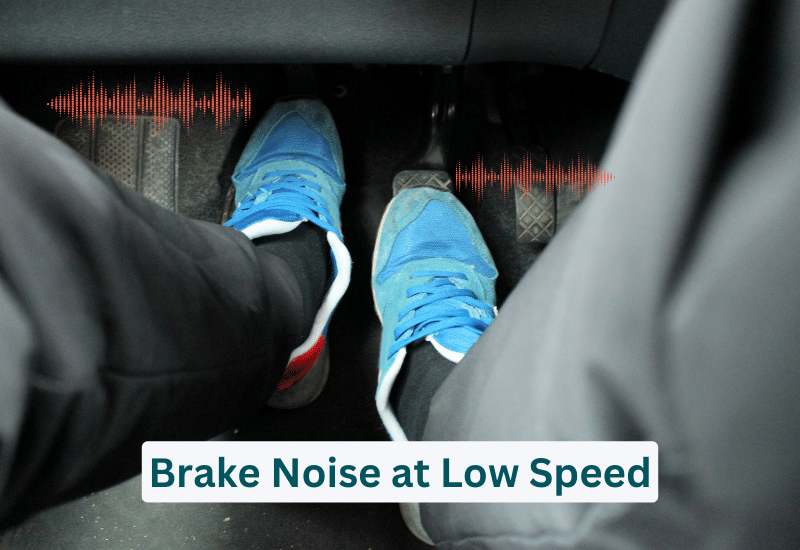
Properly functioning brakes are virtually silent, with perhaps the slightest squeak when braking hard. If your brakes start making noises at low speed, it’s often an early sign that a more serious problem has started brewing.
The most likely reasons why your brakes are making noise include worn-out brake pads, warping rotors, and brake caliper issues. Identifying the underlying cause will go a long way toward minimizing the potential size of the repair bill or at least determining if it’s something you can fix yourself.
7 Causes of Low-Speed Brake Noise
Braking noises at low speeds are usually associated with excess friction and improper contact between metal surfaces. This includes brake pads that wear down, warped rotors, and caliper problems. Each of these has its own secondary symptoms that can help you troubleshoot the problem and assess the severity.
1. Worn-Down Brake Pads
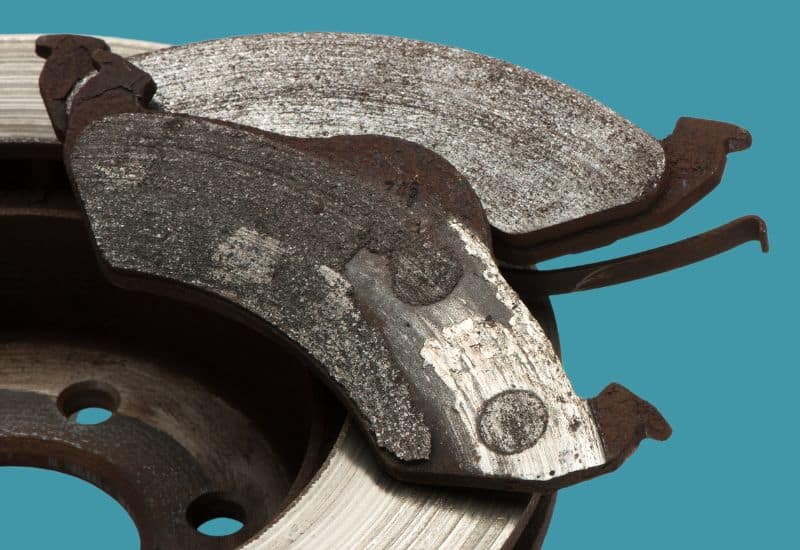
Worn-down brake pads are one of the most common reasons why a car’s brakes make noise at low speeds. Even the most high-quality brake pads have a limited lifespan. As they start to wear down the backing plate, other hard metal components can start contacting the rotors.
Though a lot of modern brake pads have special warning tabs on them that some people call “Squealers.” They make a squeaking or squealing noise when the brake pads wear down to roughly 20 to 25%. If you catch the brake noise problem at this stage, you might be able to get away with simply replacing the pads.
How to Fix Worn-Down Brake Pads
If there isn’t any damage to the calipers, and the rotors aren’t warped, you might be able to get away with just replacing the brake pads and correcting the brake fluid.
This is something that the average DIY mechanic can do. However, if the grinding damaged the rotors or too much material was lost from the brake calipers, then a total replacement might be necessary.
The cost to have a mechanic replace brake pads ranges from $120 to $300 per axle. This includes roughly $80 to $150 for parts. So, you can save up to $100 or more by replacing your own brake pads.
Note
One of the most common mistakes a lot of DIY mechanics make when replacing their own brake pads is not adjusting the brake fluid. If you add brake fluid as your pads wear down to maintain consistent brake pressure, and then you change your brake pads, the fluid level in the reservoir will be slightly too high. This is simply due to the slightly thicker new pads, which will contact the rotors sooner in the braking process.
If you don’t remove some of the brake fluid from the main reservoir, the pads might stop too suddenly. You also risk problems with brake drag due to excess pressure on the hydraulics inside the brake caliper.
2. A Loose Brake Shim or Tab
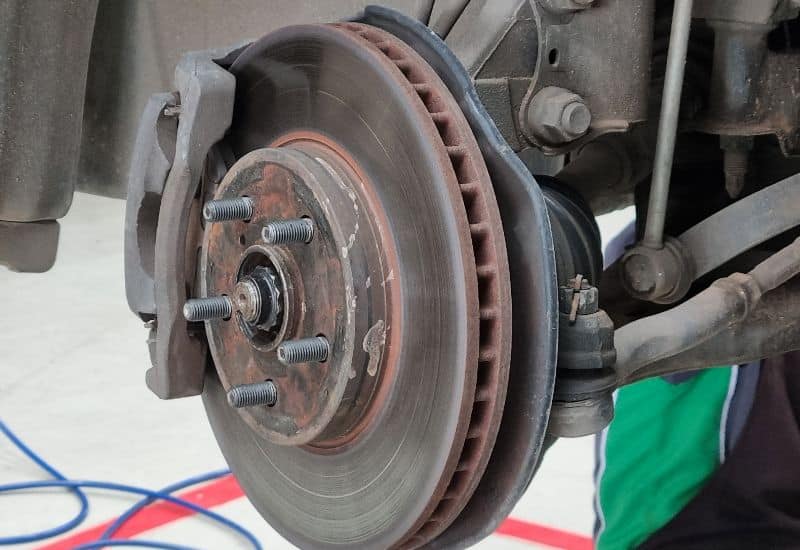
Some brake jobs include shims to make sure the brake pad meets smoothly with the rotors. If one of these rubber shims comes loose, the uneven contact can cause grinding, rasping, and squealing noises when you brake at low speeds.
In many of these cases, brake lubrication issues are at play. This can make it hard to determine whether it’s a shim problem, a caliper issue, or deformed brake pads until you remove the wheel. If you did your own brake job and you reused the shims or brake tabs from the previous brake pads, it also increases the likelihood of brake shims being the core problem.
How to Fix Loose Brake Shims
If you catch it early, you might get away with removing the existing pads and installing new shims. Then, lubricate all the moving parts in the brake system and caliper for good measure.
Make sure to take a close look at the brake pads. If the problem was left too long and the brake pad has worn unevenly, you’ll need to replace the pads completely. You can handle this fix yourself if you’re a reasonably capable DIY mechanic. Just be sure to use all-new brake pad tabs and shims.
Also, look at the rotors. Sometimes, when a brake pad shim or tab comes loose, it can get stuck in a position where it’s making constant contact with the rotor. This can start to wear a groove in the rotor, requiring you to replace it.
It’s another example of why you must get on top of low-speed brake noises as soon as possible. In a worst-case scenario, a $1 part can cause hundreds of dollars of damage to the rotor and other brake components.
3. Warped Rotors
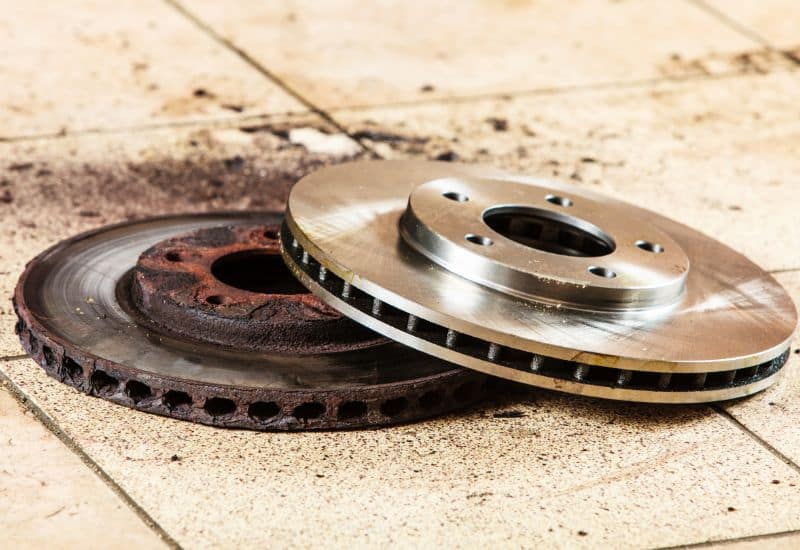
Warped, cracked, or severely worn rotors often show up early on as strange grinding or grating noises when braking at low speed. This is often due to the uneven surface of the rotors making intermittent contact with the brake pads.
As the warping effect on the rotors worsens, you’ll likely start to feel pulsing in the brake pedal, and the car will slow down in bursts. If the steering wheel is vibrating, the front rotors are likely warped. If the brake pedal vibrates and the pulsing feels stronger in the back, then the rear rotors are likely also warped. Though usually front brake pads and rotors wear out 40 to 50% faster than the back.
How to Fix Warped Rotors
If the noise only happens during low-speed braking and you don’t feel any pronounced pulsing when you brake hard, the warp in the rotors might be minor. If caught in the early stages, a mechanic might be able to resurface the rotors to smooth out minor deviations, which might cost you around $50 to $75 per rotor.
However, this really is only buying you time. The rotors are likely to warp again in the near future. At that point, you’ll need to replace both rotors on an axle completely.
Unfortunately, any time you replace the rotors, you must replace the brake pads. Otherwise, the pads will wear unevenly and quickly warp or deform the new rotors.
The parts cost for new brake rotors is relatively low, ranging between $75 to $125 per axle.
The cost for brake pads runs roughly $80 to $150 for just the parts.
Replacing brake pads and rotors is right on the edge of what a DIY mechanic can do on their own. If you’ve done it before, or you have someone who knows how to do it to help you the first time, you can save a lot of money on mechanic labor costs.
Otherwise, the cost to have a mechanic perform a rotor and brake pad replacement will add another $150 to $250 to the final repair bill.
4. Glazed Brake Rotors & Pads
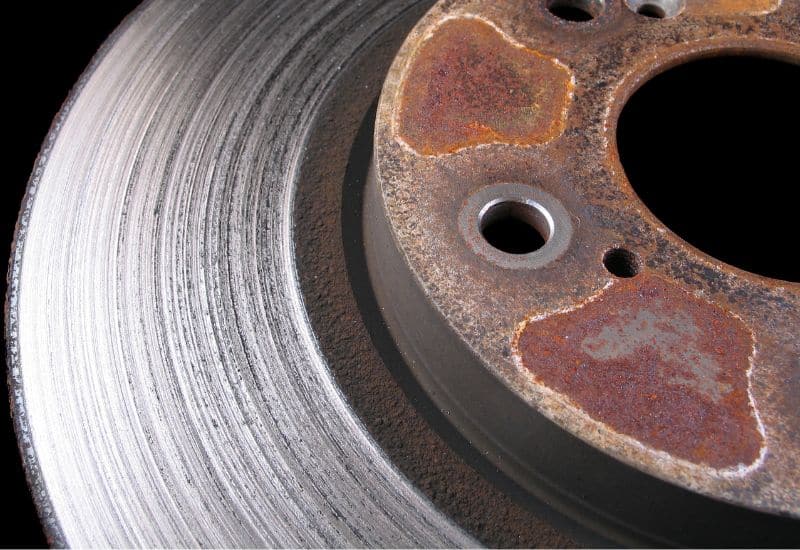
Low-quality brake pads and overheated rotors can cause pad transfer, which glazes some of the brake pad material onto the surface of the rotors, making noises when you step on the brake. Once the rotors cool down, the glazed material remains on the surface, affecting brake performance.
When you step on the brakes again, the pads contact the glazed material, making strange humming, grinding, or scratching noises. You’ll likely also notice your braking distance is much longer than usual. If only one brake rotor experienced a glazing effect, you might also notice the car pulling slightly to one side when braking at low speeds.
How to Fix Glazed Brake Rotors
If the glazing effect on the rotors is caught early and it’s minimal, you might be able to remove it yourself. This is within the range of what a DIY mechanic can handle, though if you’ve never taken a wheel off and worked with brakes, it might be better left to the professionals.
If you’re up to the challenge, you might be able to remove a minor case of brake glazing via the following steps.
If it’s suffering from glazing, you’ll see a grayish-blue sheen. This material affects the friction relationship between the brake pads and the rotors.
If there’s a severe amount of pad transfer material glazing the rotor to the point that the sandpaper can’t effectively remove it, you’ll need to take it to a mechanic to resurface the rotors. A mechanic can do this on a lathe, typically charging you between $75 and $125 per axle.
5. Road Debris Stuck in the Brakes
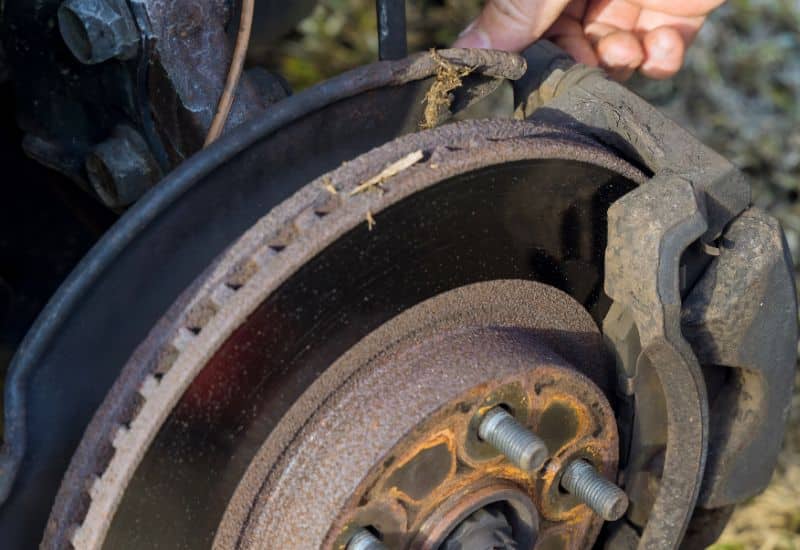
If you drive on a lot of gravel roads and loose surfaces, it’s possible for road debris like peddles to get stuck in between a brake pad or the brake shield and a rotor, causing a strange “Nails on a Chalkboard” noise when you brake at any speed. You’re just more likely to hear the noise when braking at low speed, as there’s less ambient road noise to drown it out.
This is a somewhat rare problem, so it usually only affects one brake at a time. When brake pads are reasonably new, the tolerance between the pad surface and the rotor is usually 1 to 2 millimeters. As brake pads wear down, the distance between the pad and the rotor increases. So, you’re more likely to suffer debris in older brakes.
How to Fix Debris Stuck in the Brakes
If you do have a pebble or some other road debris stuck in your brakes, it will likely be confined to one wheel. If you’re lucky, getting it out might be as simple as jacking the car up and removing the wheel.
A bamboo skewer or other non-metallic probe might be able to poke it out. Then, turn the wheel back on to ensure it’s not making any more noise. If the rock is stuck behind the brake shield, you might be able to flex the metal with your fingers to get it to fall out on its own.
6. Brake Rust
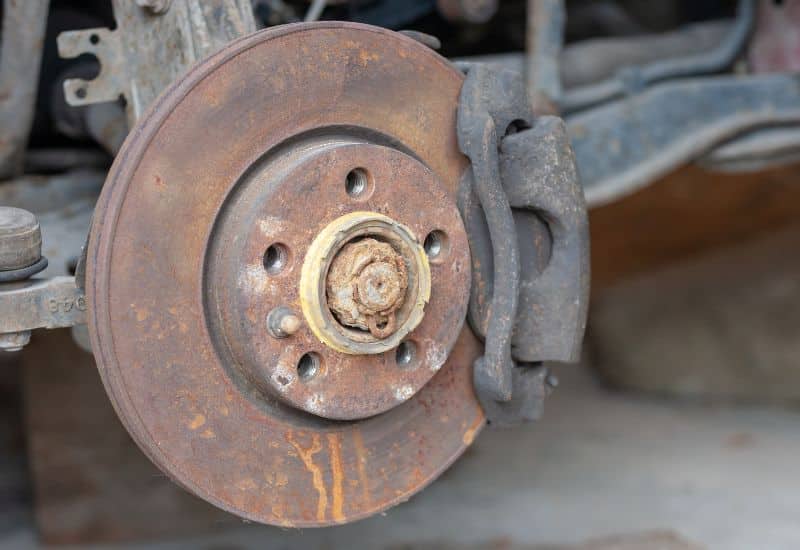
Rust on the brake pads and rotors can also make a strange grinding or scraping noise when you brake at low speed. This is even more likely to be the case if your car has been in storage or you haven’t driven it in a while.
In a severe case, the rust might infiltrate the moving parts, such as the brake caliper. This can cause the caliper to get stuck when you step on the brakes, essentially pinning the brake pad to the rotor. When this happens, you’ll notice a strange noise when you brake at low speed and then a rasping sound that continues for a while, even after you take your foot off the brake. You might even notice the car pulling to one side.
How to Fix Brake Rust
If surface rust on the brake rotors causes the strange noise, it might grind itself away. After a few miles of driving with stop-and-go traffic, the rust might fleck off, and the low-speed braking noise will gradually return to normal.
If the rusty brakes are still making a noise, then you’ll need to take a more proactive approach to releasing the rust.
If you’re lucky, you can use the same sanding method we mentioned to deal with pad-transferred glaze on the rotors.
If the rust on the rotors is modest and they aren’t warped, you might be able to remove it by having a mechanic resurface the rotor and replace the brake pads.
The cost to have rotors resurfaced will run you between $75 to $125 per axle.
If the rust on the brake pads and/or rotors is severe or the rotors show serious signs of warping, you might need to replace the rotors and brake pads. The calipers often suffer severe rust on the slides and/or guide pins. If they are also compromised, you’ll need to replace them.
The cost for a total brake system overhaul like this could range from $500 to $1,000, depending on the make, model, and the severity of the rust.
7. Stuck Brake Calipers
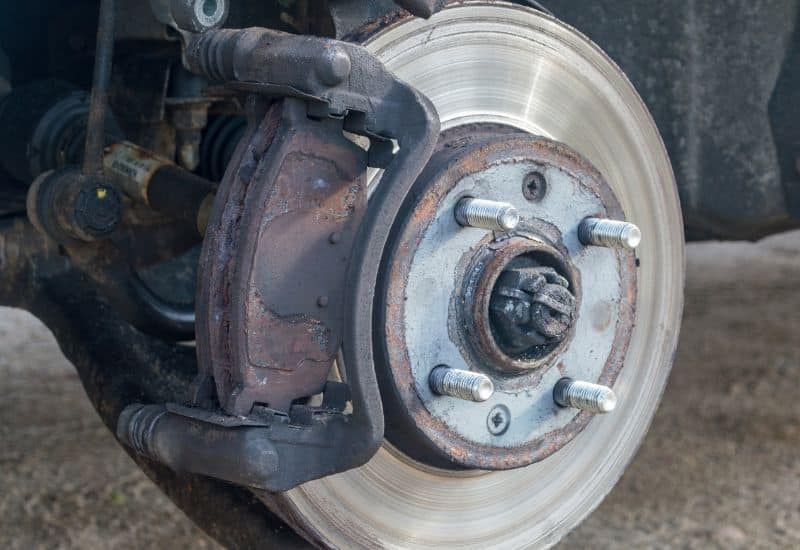
Brake calipers have pinions, slides/glide pins, and other moving parts that can suffer from rust and corrosion, which can cause low-speed braking noises. Sometimes, the caliper can get stuck in the depressed position, holding a small portion of the brake pad onto the brake rotor. If it’s due to poor lubrication, the noise might come and go as the caliper releases like normal sometimes and catches on others.
In a scenario like this, you’ll likely notice the car pulling to one side when you step on the brakes, and it makes a noise. If it also affects your steering, the offending caliper is probably on one of the front wheels. A stuck brake caliper might also cause a wheel to start smoking as the heat from friction gets intense.
How to Fix a Stuck Brake Caliper
If you catch it early, and the caliper is sticking due to a simple lack of lubrication, you might get away with lubricating the caliper’s moving parts.
If the caliper is suffering from severe rust and corrosion or the attached brake pad is worn unevenly, you’ll need to replace the pad and possibly replace the entire caliper. Though the way brakes work, you’ll have to do the pads and calipers on both sides of an axle. Even if the other caliper is performing normally if you just replace one set of pads on the rusty/stuck brake caliper, the car will pull to one side, and you’ll have braking imbalances that affect handling.
The part cost for a new brake caliper can range from $100 to $175 per axle.
You’ll also need to get new brake pads, which can run from $45 to $150, with an average right around $100 for two sets of average pads.
Replacing both brake calipers and pads is right on the verge of what a DIY mechanic can handle. The big concern is that when you replace the caliper, you have to bleed the hydraulic brake lines, or you risk air getting trapped in them. If you get this wrong, you’ll have spongy, unresponsive brakes.
If you take your car to a mechanic, it will add another $125 to $275 to the final repair bill of $275 to $600, with a real-world average of around $450.
If the rotors have also been damaged by uneven wear with the brake pads, then you might also have to shoulder that cost. This is why it’s so important not to procrastinate brake noises like this!
Consider Getting a Brake Inspection
A simple break inspection is handy if you don’t have a lot of experience working with automotive brakes or you don’t have the time to tear into your brake system to figure out what’s causing the noise when you brake at low speed. You can get one performed pretty much anywhere that offers tire rotation.
A basic brake inspection typically costs between $50 to $80. A lot of times, it’s even included in a dealership’s service package. It gives you peace of mind knowing that a trained professional is diagnosing your brake system, which lets you make more informed decisions about fixing the brake noise problem.
Frequently Asked Questions
What is the Best Type of Lubricant for Brakes?
If you have a stuck caliper or improperly lubed brake pad components, then you need to lubricate all the moving parts with silicone-based brake lube. Just be sure not to get any on the friction surfaces of the brake pads or the brake rotors, as it could significantly impact braking distance.
How Much Brake Pads Are Left When Squealers Start Making Noise
Brake wear indicators, which are often called “Squealers,” usually start making noise when you have two to three millimeters of brake pad left. They’re meant to tell you that it’s time to replace the brake pads before there’s direct metal-on-metal contact with the rotors. Usually, when they start making noise, the wise move is to have the pads replaced in the next week or two.
Conclusion
If you’re lucky, your low-speed braking noises are simple, like brake wear indicators or a light layer of rust. Replacing the pads and/or getting the rotors cleaned or resurfaced is usually a cheap fix for these issues.
Yet more serious problems can cause your brakes to make strange noises at low speeds that need to be fixed as soon as possible. A stuck caliper, warped rotors, or loose brake pads can cause major damage to your brake system. If you notice signs of these problems, such as the car pulling to one side when you brake at low speed, severe grinding, or rasping noises, you must take care of it immediately.
If caught early, you might only need to have the brake pads replaced, the brake system lubricated, or the rotors resurfaced to get rid of the low-speed braking noise. These fixes typically cost less than $150, and you might even be able to do them yourself.
More major faults that cause low-speed braking noises might require calipers, brake pads, and rotor replacement. These fixes usually need to be done simultaneously, which can add up to a major repair bill.

Written By
Jason Farrell
Jason Farrell is a certified master technician, the editor of Mechanic’s Diary in Pittsburgh, Pennsylvania. He is ASE (Automotive Service Excellence) certified and earned a Bachelor’s Degree in Automotive Technology from Pittsburg State University. With nearly 18 prior years of experience in the automotive field, he has extensive knowledge about Domestic, European, and other foreign makes and models of cars and light trucks. Jason’s experience working as a technician and service manager at dealerships, gave him the experience and know-how of most aspects of inspection, diagnosis, and repair from engine and drivability to electrical, HVAC, brakes, steering and suspension and everything in between.

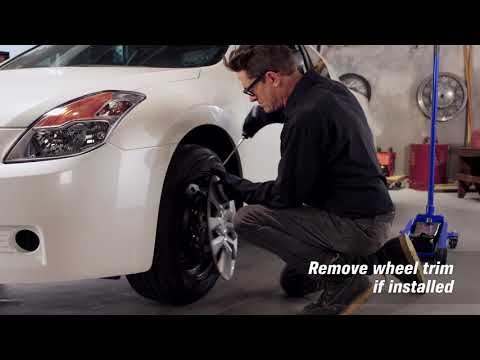
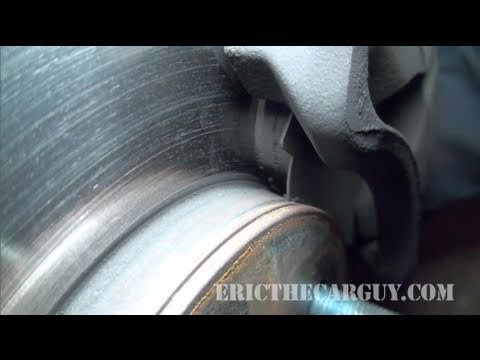
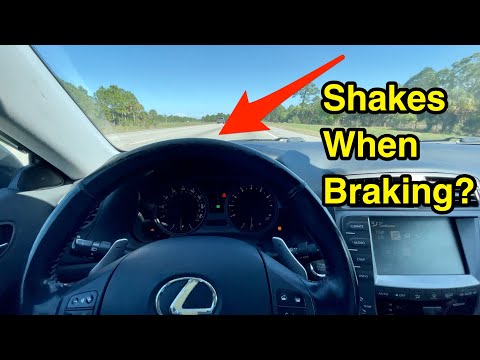
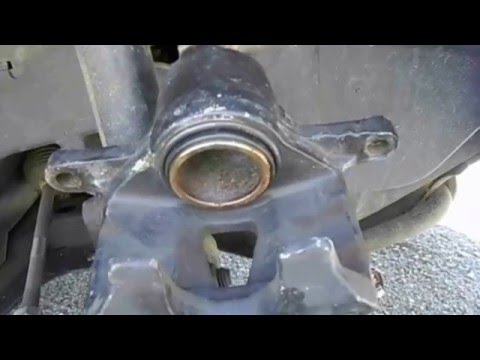
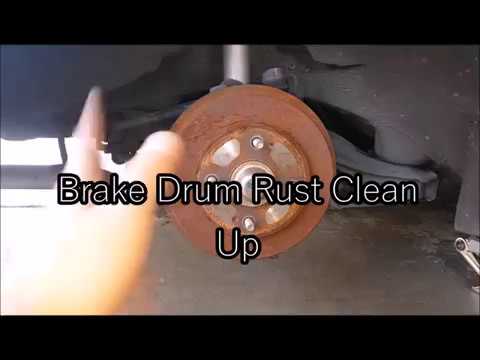
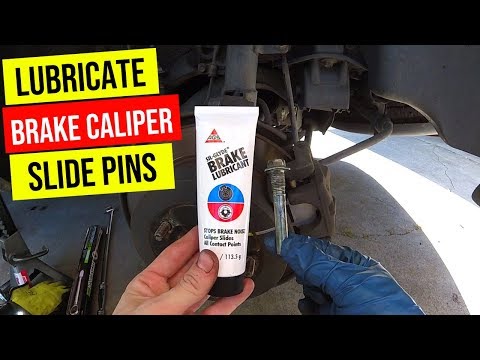
What if you have new brake pads , new rotors , new calipers , new brake line and you still hear a dragging slightly hollow shudder type grinding type noise when braking at low speed especially when going down a slight incline . This is not a “I just got new brake pads type noise either” . I’ve also noticed excessive black dust on drivers side front wheel more than other wheels .